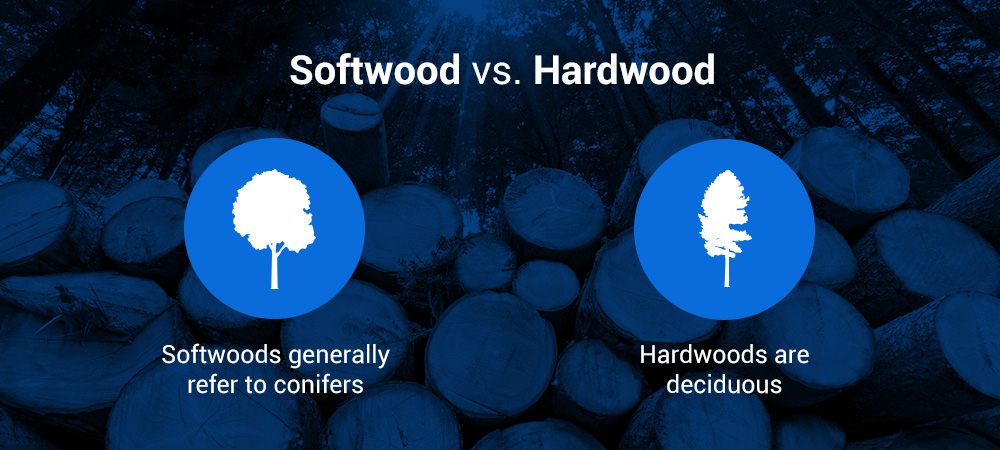Chapter 3: Guide to Sawmill Blades
Selecting the right blade for your sawmill is critical for performance, safety and producing the results you want. It’s also important to choose the correct cutting tool for your machine to avoid blade damage.
Before you shop for a sawmill blade, you’ll need to know what to look for and the type of wood you plan to cut. In this chapter, we’ll go over the parts of a sawmill blade, factors to consider when selecting a blade and what you can expect to pay for a new sawing tool.
Parts of a Sawmill Blade
Sawmill blades are available in many different designs, thicknesses and widths. Before selecting a blade for an industrial sawmill, it helps to know the different blade parts and how they function.

You can expect to find the following features in a typical blade:
- Teeth: All blades have teeth that function like knives and simultaneously cut and release wood. Generally, a blade with more teeth will produce a smoother cut than a blade with fewer teeth. However, blades with fewer teeth typically cut faster.
- Tooth pitch: The tooth pitch is the distance between tooth tips. The closer the teeth spacing, the less powerful each tooth. A wider tooth pitch is used for longer blades that run at high speed. Consider tooth pitch when selecting a blade to ensure it’s strong enough to cut through your chosen material.
- Gullet: The gullet is the rounded space between the teeth. Gullets store sawdust as a blade moves through a workpiece.
- Gullet depth: Gullet depth measures the distance from the lowest point of the gullet to the tooth tip. Blades meant for cutting softwoods such as pine or balsam have deeper gullets, while blades designed to cut through hardwoods like ash and hickory have shallower gullets. A deeper gullet produces a bigger chip. It’s essential to choose a gullet size that’s deep enough for the cut. A large log needs bigger gullets than small logs. A too-small gullet slows the bite and could lead to blade wandering or overheating.
- Tooth angle: The tooth angle measures the number of degrees a tooth leans forward in relation to the center of the blade. Choose a tooth angle while considering the material you plan to cut. Usually, a dense, strong wood requires a high hook angle. High hook angles are also the preference for rip-cutting and resawing, and act more like a chisel. Low hook angles perform more like a scraper than a chisel and are usually preferred for cross-cutting.
- Tipping: Blades may feature a finished swage or Stellite-tipped teeth that stay sharper longer. Stellite-tipped blades are ideal for heavy-duty cutting and help reduce downtime because they stay sharp. Carbide and chrome are also durable tipping materials.
- Blade width: Blade width refers to the distance between the body of the blade and the tip of the teeth. Wide blades are designed for high horsepower sawmills and a fast feed rate. Narrow blades are built for low horsepower sawmills. A band saw will come with width specifications, but generally, the wider the blade, the straighter the cut.
- Blade metal: There are many different blade materials to choose from. The type of metal used affects the life span of the blade. Carbon steel is the most common metal used to manufacture sawmill blades and performs well for high production. It’s possible to add other metals to a blade’s composition to enhance its durability. Either way, the blade metal must be both flexible and hard. The flexibility allows a band saw blade to travel as a band while the hardness gives the teeth the strength to cut.
- Tooth type: Generally, there are four different tooth types — standard or raker, rounded, hook or skip. Tooth type is the most critical element to consider when you want a quality cut. Standard teeth are equally spaced and recommended for general use. This tooth type is often used for narrow band saw blades. Rounded teeth are commonly seen in wide blades and have great strength at the teeth points. Hook teeth have wide round or flat gullets and are suitable for speedy rip-cutting. Skip teeth are less aggressive than hook teeth, have wide flat gullets, and are ideal for cutting thick wood or undried wood.
Choosing a Sawmill Blade
Choosing a sawmill blade requires careful consideration. The wrong cutting tool for your machinery can result in various issues, from slowed productivity to a damaged blade. You’ll need to think about several factors when selecting the right blade for your sawmill, such as:
- The type of materials you will be cutting
- Whether you need faster or slower feed rates
- If it’s most important to have smooth cuts
- If you require both speed and smoothness
- The thickness and quality of the blade, which will affect the width of the kerf
- The type of cuts the blade will make
- The power of the sawmill
- The sawmill manufacturer’s blade recommendations
Tooth specifications are critical to most industrial sawmills. Certain teeth are ideal for the type of wood a sawmill is cutting, whether it is hardwood or softwood, and the power they’re using to cut the lumber. Call us at York Saw and Knife Co, Inc., and we’ll help you select the right blade for your needs, or custom-make a blade to meet your specifications.
Circular vs. Band Sawmill Blades
Some industrial sawmills have the means to employ both circular saws and band saws. If you need to choose between one or the other, consider what’s most important for your business –– kerf size or production speed. Generally, circular blades are best for fast cutting while band saw blades produce the least amount of kerf. We’ll cover the pros and cons of both types to help you determine the ideal blade for your mill.
Circular Blades
Circular saw machines use blades that are thicker than band saw blades, such as carbide-tipped blades. Carbide-tipped blades feature minimal blade vibration, smooth cuts and a high feed rate.

Circular saw machines and carbide-tipped blades are an excellent choice where speed, quality and accuracy are needed. They also make a practical saw for cutting large beams. Circular blade mills typically require less maintenance and can process double the amount of lumber than band saw mills.
Tooth spacing and number vary with circular saw blades. Conventional circular saws have the same space size between each tooth. Variable pitch (VPD) circular saw blades feature teeth spacing that varies between teeth. The variable design helps reduce vibrations.
Circular sawmill blades under 14 inches wouldn’t typically be used in an industrial sawmill. At York Saw and Knife Co, Inc., our most popular circular sawmill blade size has a 24-inch diameter.
Band Mill Blades
Band saw machines use a thin continuous strip of steel as a blade. They require less power than circular sawmills and produce less kerf loss. Band saws are a more economical and versatile option if high productivity is not a concern. You can get up to 20% more lumber out a log with a band saw blade than a circular blade and a kerf of about 3/32 inch versus 1/4 inch. A band saw offers great flexibility allowing you to cut smooth, unusual shapes to make anything you want for customers.
Wide band saw blades are used for industrial sawmilling purposes. Modern wide band saw blades are huge steel belts which may be 14 inches wide. They travel over pulleys and cut through large logs that are too big for circular saws. Wide band saw blades are manufactured to suit an industrial sawmill’s production needs. There are several types of wide band saw blades, such as Stellite-tipped blades, which are ideal for working with hardwoods. Large sawmills require stationary band saw machinery to produce quality lumber efficiently.
Band saws are the most widely used machines for cutting logs. Typically, a band saw mill would produce a higher yield of board feet than a circular mill even though circular saws cut faster.
Cutting Hardwood vs. Softwood
When you hear the terms hardwood and softwood, you might think a hardwood tree would be more difficult to cut than a softwood. Although this is often the case, hardwood does not necessarily mean a block of wood is harder or stronger than a softwood. For example, Pacific yew is a very hard softwood, and black cottonwood is an incredibly soft hardwood. Another example is balsa wood, which is considered a hardwood and also one of the lightest, least dense woods available.

Softwoods generally refer to trees that have needles and are known as conifers such as pines, firs and spruces. Softwoods grow quickly and are, therefore, typically less expensive than hardwoods. Cedar is a type of softwood commonly used in building furniture and outdoor areas like decks due to its resistance to moisture and insects. Douglas fir is a hard, strong softwood often used in furniture making and construction. Pine is an example of a softwood that’s durable enough to be used in furniture making, but which is also easy to cut and shape –– perfect for carving details.
Hardwoods are deciduous, which means they lose their leaves at the end of the growing season. Hardwoods tend to be denser than softwoods and can be more difficult to saw and require more labor and time. Hardwoods also grow more slowly than softwoods, which contributes to a higher price tag. This type of wood is valued for its durability as well as its variety of colors and patterns and is the preferred choice for building fine furniture and gorgeous flooring. Examples of hardwoods include oaks, maples and birches.
The Janka hardness test measures a wood’s resistance to dents and wear, and demonstrates the hardness of different wood species. If you compare trees using Janka measurements, you can get an idea of how difficult it would be to cut a specific type of tree. The higher the number on the Janka scale, the harder the wood. For example, the longleaf pine, a softwood tree, is given a rating of 870. Black cherry, a hardwood, is given a rating of 950 –– not much harder than the pine. Some hardwoods are very hard, like Brazilian walnut, which gets a rating of 3680. Although there’s more to consider than tree hardness when choosing a cutting method, it is worthwhile to think about tree species before feeding it into a sawmill because they vary so much. A mismatched tree and blade could lead to a damaged blade.
Consider the tooth design when choosing a blade for cutting hardwood or softwood. For example, cutting a dense exotic wood calls for the use of Stellite-tipped or carbide-tipped blades, which will stay sharper longer. Also, consider tooth pitch, height and gullet. Problems such as overheating or cracks in the saw can result from a too-narrow gullet.
Price of Sawmill Blades
Band saw blades with widths of 4 to 14 inches can cost anywhere from $300 to $1,600 depending on length, width, tooth pattern, tipping and other factors. Circular blades range from 14 inches to 30 inches and are generally going to cost around $100 to $300, but this will also vary based on tooth pattern, tipping, shipping and more.

